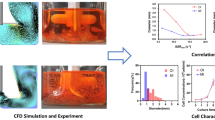Abstract
The effects on human mesenchymal stem cell growth of choosing either of two spinner flask impeller geometries, two microcarrier concentrations and two cell concentrations (seeding densities) were investigated. Cytodex 3 microcarriers were not damaged when held at the minimum speed, NJS, for their suspension, using either impeller, nor was there any observable damage to the cells. The maximum cell density was achieved after 8–10 days of culture with up to a 20-fold expansion in terms of cells per microcarrier. An increase in microcarrier concentration or seeding density generally had a deleterious or neutral effect, as previously observed for human fibroblast cultures. The choice of impeller was significant, as was incorporation of a 1 day delay before agitation to allow initial attachment of cells. The best conditions for cell expansion on the microcarriers in the flasks were 3,000 microcarriers ml−1 (ca. 1 g dry weight l−1), a seeding density of 5 cells per microcarrier with a 1 day delay before agitation began at NJS (30 rpm), using a horizontally suspended flea impeller with an added vertical paddle. These findings were interpreted using Kolmogorov’s theory of isotropic turbulence.




Similar content being viewed by others
References
Abranches E, Bekman E, Henrique D, Cabral JMS (2007) Expansion of mouse embryonic stem cells on microcarriers. Biotechnol Bioeng 96:1211–1222
Allegrucci C, Young LE (2007) Differences between human embryonic stem cell lines. Hum Reprod Update 13:103–120
Barker C, Culme-Seymour E, Dalton S, Hayek A, Genbacev O (2011) The year in regenerative medicine. Regen Med 6:21–30
Butler M (1996) Cell line and culture monitoring. The basics: animal cell culture and technology. IRL Press, New York, pp 33–45
Cherry RS, Papoutsakis ET (1986) Hydrodynamic effects on cells in agitated tissue culture reactors. Bioprocess Eng 1:28–41
Cherry RS, Papoutsakis ET (1988) Physical mechanisms of cell damage in microcarrier cell culture bioreactors. Biotechnol Bioeng 32:1001–1014
Croughan MS, Hamel J-F, Wang DIC (1987) Hydrodynamic effects on animal cells grown in microcarrier cultures. Biotechnol Bioeng 29:130–141
Croughan MS, Hamel J-F, Wang DIC (1988) Effect of microcarrier concentration in animal cell culture. Biotechnol Bioeng 32:975–982
Croughan MS, Sayre ES, Wang DIC (1989) Viscous reduction of turbulent damage in animal cell culture. Biotechnol Bioeng 33:862–872
Frauenschuh S, Reichmann E, Ibold Y, Goetz PM, Sittinger M, Ringe J (2007) A microcarrier-based cultivation system for expansion of primary mesenchymal stem cells. Biotechnol Prog 23:187–193
GE Healthcare (2009) Cytodex™ surface microcarriers. Data file 18-1060-61 AF
Hu WS, Meier J, Wang DIC (1985) A mechanistic analysis of the inoculum requirement for the cultivation of mammalian cells on microcarriers. Biotechnol Bioeng 27:585–595
Ibrahim S, Nienow AW (2004) Suspension of microcarriers for cell culture with axial flow impellers. Chem Eng Res Des 82:1082–1088
Kresta SM, Brodkey RS (2004) Turbulence in mixing applications. In: Paul EL, Atiemo-Obeng VA, Kresta SM (eds) Handbook of industrial mixing, Chap 2. Wiley-Interscience, Hoboken, pp 19–87
Kumar N, Gammell P, Meleady P, Henry M, Clynes M (2008) Differential protein expression following low temperature culture of suspension cho-k1 cells. BMC Biotechnol 8:42
Nagata S (1975) Mixing; principles and applications. Kodansha, Tokyo
Nienow AW (1997a) The suspension of solid particles. In: Harnby N, Edwards MF, Nienow (eds) Mixing in the process industries, Chap 16, 2nd edn (paperback revision). Butterworth Heinemann, London, pp 364–393
Nienow AW (1997b) The mixer as a reactor — liquid/solid systems. In: Harnby N, Edwards MF, Nienow (eds) Mixing in the process industries, Chap17, 2nd edn (paperback revision). Butterworth Heinemann, London, pp 394–411
Nienow AW (2006) Reactor engineering in large scale animal cell culture. Cytotechnology 50:9–33
Nienow AW (2010) Impeller selection: animal cell culture, In: Encyclopedia of industrial biotechnology, vol 5. Wiley, Hoboken, pp 2959–2971
Nienow AW, Conti R (1978) Particle abrasion at high solids concentration in stirred vessels. Chem Eng Sci 33:1077–1086
Oh SKW, Nienow AW, Al-Rubeai M, Emery AN (1992) Further studies of the culture of mouse hybridomas in an agitated bioreactor with and without continuous sparging. J Biotechnol 22:245–270
Oh SK, Chen AK, Mok Y, Chen X, Lim UM, Chin A, Choo AB, Reuveny S (2009) Long-term microcarrier suspension cultures of human embryonic stem cells. Stem Cell Res 2:219–230
Paul EL, Atiemo-Obeng VA, Kresta SM (2004) Handbook of industrial mixing. Wiley-Interscience, Hoboken
Rushton JH, Costich EW, Everett HJ (1950) Power characteristics of mixing impellers. Chem Eng Prog. 46:467–471
Schutt C, Furll B, Stelter F, Jack RS, Witt S (1997) CHO transfectants produce large amounts of recombinant protein in suspension culture. J Immunol Methods 204:99–102
Sucosky P, Osorio DF, Brown JB, Neitzel GP (2004) Fluid mechanics of a spinner-flask bioreactor. Biotechnol Bioeng 85:34–46
Thomas CR, Zhang Z (1998) The effect of hydrodynamics on biological material. In: Galindo E, Ramirez OT (eds) Advances in bioprocess engineering. Kluwer, London, pp 137–169
Thomson H (2007) Bioprocessing of embryonic stem cells for drug discovery. Trends Biotechnol 25:224–230
Venkat RV, Stock LR, Chalmers JJ (1996) Study of hydrodynamic in microcarrier culture spinner vessels: a particle tracking velocimetry approach. Biotechnol Bioeng 49:456–466
Acknowledgments
The authors would like to acknowledge the financial support of the Biotechnology and Biological Sciences Research Council (UK) and Smith and Nephew (York, UK) for their financial support.
Author information
Authors and Affiliations
Corresponding author
Rights and permissions
About this article
Cite this article
Hewitt, C.J., Lee, K., Nienow, A.W. et al. Expansion of human mesenchymal stem cells on microcarriers. Biotechnol Lett 33, 2325–2335 (2011). https://doi.org/10.1007/s10529-011-0695-4
Received:
Accepted:
Published:
Issue Date:
DOI: https://doi.org/10.1007/s10529-011-0695-4




